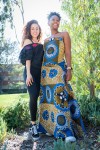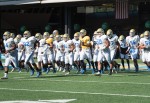Last year, Caliope Marin and Risachi Ogan walked the runway at an annual fashion show.
This year, they designed the clothes instead of wearing them.
Marin, a third-year neuroscience and human biology and society student, and Ogan, a fourth-year molecular, cell and developmental biology student, said they witnessed a lack of body-type diversity in the 2018 Fashion and Student Trends at UCLA fashion show. Walking as models opened their eyes to how Eurocentric styles dominated the show, and they were motivated to design their own line, Curvy in Color, in hopes of inspiring all women to feel beautiful and empowered, Ogan said.
“A lot of the designers didn’t fit the models, so a lot of the women that are curvier were left out,” Marin said. “It is 2019 – we should be celebrating all different types of bodies, sizes and colors – and we weren’t seeing that.”
Marin and Ogan designed a 10-piece clothing line that fuses Marin’s Mexican heritage with Ogan’s Nigerian culture. With pieces ranging from streetwear to formal dresses, Marin and Ogan said they integrated both backgrounds by using vibrant colors, culturally distinct patterns and various fabrics prominent in both cultures that could fit models of varying sizes.
Marin used patterns like those of serapes – which are brightly colored shawls – and Huichol floral prints that she purchased at Mercado Hidalgo, a large marketplace which sells souvenirs, clothes and food from Tijuana, Baja California. She also incorporated roses into her designs, as she said they are symbolic of beauty and hope in Mexican culture. The roses will be added as patterns on dresses and used as accessories in the models’ hair, Marin said. Marin also included off-the-shoulder blouses and dresses; while the trend may be popular in America, the look originated from Pueblo women, she said.
Additionally, Ogan said they tried to infuse traditional American styles of clothing to reflect how they both grew up in the United States. One of their pieces was inspired by an old, green men’s button-up they found at Goodwill. They found a similar fabric at an African fabric store in Downtown Los Angeles and paired the top with a mustard-yellow pattern because African fabrics, specifically Ankara prints, often incorporate bright colors, Ogan said. In this way, Marin and Ogan were able to depart from typical Eurocentric styles while still portraying their American identity.
“You can still be proud of who you are while acknowledging that we are American,” Marin said. “We can wear the same stuff and still celebrate where we come from.”
Despite their goal to celebrate their cultural identities through clothing, Ogan said she was concerned about cultural appropriation because not every model reflects the culture their outfit celebrates. However, she said she believes people can wear styles from different cultures as long as they are educated about the clothing’s origins and significance. Marin and Ogan prepared a speech they will give during the dress rehearsal about why they chose to use the fabric the models are wearing and the cultural significance of each aspect of their designs.
Ogan said they also want to promote body positivity through their designs. When she was model in the 2018 show, Ogan was unable to model certain lines because the designers did not take her measurements before the dress rehearsal. While Ogan still walked for some designers, she said the experience adversely affected her self-esteem. She hopes to combat this by taking the measurements of all their models and then creating each outfit specifically to their measurements, she said.
One of the Curvy in Color’s models, third-year sociology and Chicana and Chicano studies student Roselia Rodriguez, said she will model a dress with a rose pattern. She said Marin and Ogan’s designs will help empower young girls who feel as if they do not fit into the “skinny category” to feel confident.
“I feel excited and honored to be representing a body type that has been stereotyped as not beautiful because we are indeed absolutely gorgeous,” Rodriguez said.
In addition to celebrating more body types, Marin said she hopes their line can expose people to the beauty of other cultures. Ogan said their primary goal with Curvy in Color is to challenge society’s ideals of what and who is viewed as attractive and fashionable.
“People should feel beautiful in both their cultures and their bodies, regardless of what they are wearing,” Ogan said. “We shouldn’t be trying to fit clothes, we should be making clothes that fit us, the person.”






